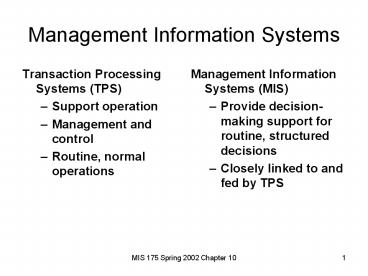Management Information Systems - PowerPoint PPT Presentation
Title:
Management Information Systems
Description:
Transaction Processing Systems (TPS) Support operation Management and control Routine, normal operations Management Information Systems (MIS) Provide decision-making ... – PowerPoint PPT presentation
Number of Views:1112
Avg rating:3.0/5.0
Title: Management Information Systems
1
Management Information Systems
- Transaction Processing Systems (TPS)
- Support operation
- Management and control
- Routine, normal operations
- Management Information Systems (MIS)
- Provide decision-making support for routine,
structured decisions - Closely linked to and fed by TPS
2
Management Information Systems
- Terminology Confusion
- MIS the study of information technology in
business settings - But, MIS is also term to refer to class of
systems used to support operational and tactical
decisionmaking
3
A Model for Problem Solving
- Decision Making Phase
- Intelligence gathering
- Design
- Choice
- Implementation
- Monitoring
4
Decision Making
- A step in problem solving
- Intelligence gathering
- Definition of problem
- Data gathered on scope
- Constraints identified
- Design phase
- Alternatives identified and assessed
- Choice
- Selection of an alternative
5
Structured vs. Unstructured Problems
- Structured problems lend themselves to programmed
decisions - The implication is that a repeatable process can
be employed and these can be automated - Unstructured problems require unprogrammed
decisions
6
Unstructured Problems
- Can be addressed (or partially addressed) with
Decision Support Systems
7
Structured Problems
- Can be addressed by an MIS
- Three decision models or techniques
- Optimization
- Find the best solution
- Satisficing
- Find a solution which meets certain criteria
- Heuristics
- Rule-based solution generation
8
Goals of an MIS
- Provide managers with information
- Regular, routine operations
- Control, organize and plan better
9
Typical Inputs and Outputs
- Inputs Information from the TPS
- Outputs hard and softcopy reports
- Scheduled reports
- On-demand reports
- Key-indicator (business fundamentals)
- Exception reports
10
Functional Perspectives of MIS
- Financial MIS
- Will integrate information from multiple sources
- Functions
- Costing
- PL reporting
- Auditing
- Funds management
11
Functional Perspectives of MIS
- Manufacturing
- Design and Engineering
- Master Production Scheduling
- Inventory Control
- Materials Planning
- Manufacturing and Process Control
- Quality Control
12
Functional Perspectives of MIS
- Marketing
- Market research
- Web-based market research
- Pricing
13
Functional Perspectives of MIS
- Transportation and Logistics
- Route and schedule optimization
- Human Resources
- Accounting
14
Decision Support Systems
- Used for unstructured problems
- Characteristics
- Data from multiple sources internal and external
to organization - Presentation flexibility
- Simulation and what-if capability
- Support for multiple decision approaches
- Statistical analysis
15
Components of a DSS
- Model management software
- Provides a variety of solution models
- Financial, statistical, graphical, project
management - Dialogue Manager
- Allows user interaction with DSS
16
Group Decision Making Systems
- Very interesting field
- How can information technology improve how
decisions are made by groups?
17
Group Decision Making Systems
- Applications
- Where time is critical
- Where participants are geographically dispersed
- Where authority obstructs communication
- Military
- Business
- Government
18
Group Decision Making Systems
- Common characteristics
- Meeting moderation/facilitation
- Signed and anonymous comments
- Structured deliberations
- Presentation period
- Comment period
- Automated collation of comments
- Voting
- Face-to-face and remote
19
Executive Information Systems
- What information does a chief executive of board
member require?
20
Executive Information Systems
- High level with drill down
- Key business and industry data
- Structured and unstructured information
- Structured MTD orders
- Unstructured Industry newsfeed
- Graphical































